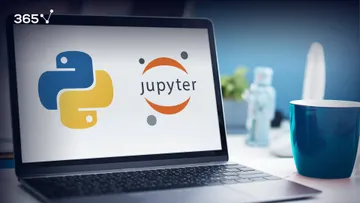According to our 2024 research into the data science job market, Python is the most frequently mentioned programming language in job postings—making it the top choice of employers and professionals alike.
In fact, it has become a key prerequisite to landing a job in data science.
Luckily for students and those new to the field, Python is also widely considered the most beginner-friendly programming language out there. So, if you’re an aspiring data analyst or data scientist, learning Python is certainly the way to go.
Our goal is to ensure each step of your learning journey is straightforward and enjoyable, and the skills you gain are applicable to a real-world context.
If you have basic Python experience and are looking to advance your knowledge, our Intermediate Python Programming course is an excellent starting point. And for those aiming to gain some hands-on experience, continue reading. This article features four engaging Python projects for beginners, each accompanied by practice code!
Prepared Python Projects
Before we start exploring beginner Python projects, we have something valuable to share. As an integral part of our learning platform, you can access a wide variety of Python projects to help you practice your skills and build a job-ready portfolio.
The beauty of these projects lies not only in the practical skills you'll gain, but also in the valuable additions they make to your portfolio. A well-rounded portfolio showcasing your diverse range of projects is a powerful way to demonstrate your abilities to potential employers—showing them not just that you understand Python, but that you know how to apply it to solve real-world problems.
Here are the Python projects we have prepared for you:
- Prime Numbers in Python Project (Beginner, 1 hour) (free)
- Music Genre Classification Project with PCA and Logistic Regression (Intermediate, 3 hours)
- Machine Learning for User Classification Project (Intermediate, 10 hours)
- Encryption and Decryption in Python Project (Intermediate, 8 hours)
- Real Estate Market Analysis with Python Project (Advanced, 18 hours)
- Customer Segmentation in Marketing with Python Project (Advanced, 5 hours)
- Building Conway's Game of Life in Python Project (Advanced, 15 hours)
- User Journey Analysis in Python Project (Advanced, 13 hours)
- Tracking User Engagement with SQL, Excel, and Python Project (Advanced, 25 hours)
Remember, completing projects is not just about learning—it's about applying Python in a practical context. Start on these projects today to build a standout portfolio.
Now, let’s explore some more Python project ideas that you can set up yourself.
4 Essential Python Projects for Beginners (with Code!)
- Uber Trips Analysis
- The Discovery of Handwashing
- Predicting Parkinson’s Disease with XGBoost
- Detecting Fake News
- FAQs
Python Project 1: Uber Trips Analysis
Since it was founded in 2009, Uber has become one of the most famous unicorn companies, offering its services to more than 80 countries worldwide.
This Python project for beginners aims to analyze Uber rides to detect specific patterns, such as the busiest day or the time with the lowest number of rides.
And as you might expect, this is the easiest project to start with. You will get familiar with the common steps of analyzing a dataset and how to draw insights from data through visualizing the relationship between different variables.
In my opinion, there are 3 main reasons why this is an interesting Python project to try out. First, it’s really easy and doesn’t take much time. Second, since it’s famous, thousands of people have shared their code on GitHub and Kaggle, so you have the chance to discover different ways to analyze the same dataset. And, finally, despite its simplicity, this quick project is quite useful because it will help you solidify the foundational rules of coding in Python.
What Will You Learn from This Python Project?
- Read a dataset and display records from it
- Use your detective’s hat and uncover hidden patterns in data
- Find the relationship between different variables
- Draw insights by visualizing these relationships
Python Project 2: The Discovery of Handwashing
Prior to the nineteenth century, hygiene was frowned upon. People simply didn’t understand the risk of not washing their hands. This unreasonable behavior caused many deaths, especially in hospitals where most doctors—unlike today—never washed their hands before surgeries. In the mid-1800s, the Hungarian physician, Dr. Ignaz Semmelweis, decided to do something about this tragedy. He started investigating the reasons behind the deaths in Vienna general hospital and those of women giving birth in particular. After analyzing data from Clinic 1 and Clinic 2, it turned out the proportion of deaths in Clinic 1 is much higher than that in Clinic 2.
By looking further into why this happened, Dr. Semmelweis realized that many of the medical students who worked at Clinic 1 also spend a lot of time in the autopsy room as a part of their studies. So, he realized that dealing with corpses spread harmful bacteria that was transferred to the women giving birth, thus infecting them with the deadly childbed fever - the main reason for the high mortality rates.
What’s truly exciting about this project compared to the other Python projects for beginners, is that you will recreate the steps that someone did 200 years ago! But this time using advanced technology.
And when you’re done with the project, I believe you’ll appreciate what Dr. Semmelweis did and realize how one simple thing can truly save lives.
Dr. Semmelweis ordered the doctors to wash their hands in the summer of 1847. From that point onwards, the proportion of deaths decreased by around 6.7 to 10 percentage points. Truly impressive!
What Will You Learn from This Python Project?
- Read a dataset and display records from it
- Display the relationship between variables through different periods
- Perform some calculations to create new variables
- Visualize the effect of handwashing on decreasing the number of deaths
Python Project 3: Predicting Parkinson’s Disease with XGBoost
Can you improve people’s health and save their lives with just a few lines of code?
The answer is yes.
Data science has countless applications in healthcare, and one of them is to predict certain diseases, especially chronic ones. Consider this. If you’re planning to go out, you normally check the weather news the day before so that you can prepare. if it’s going to rain, you’ll grab an umbrella and wear a raincoat. And if the forecast says it is going to be hot, you’ll wear light clothes. The same approach is valid for disease prevention. If you are aware of the risk to catch a certain disease, you will have the time to think and prepare, which can save a lot of suffering and money.
In this project, you’ll carefully analyze a dataset of 195 records to predict the likelihood of having Parkinson’s disease using an XGBBoost model.
So, what is special about this Python project for beginners?
Until now, Parkinson’s disease can neither be diagnosed nor treated. The doctor assesses the symptoms and decides based on the medical history. The idea of this project is to predict the risk of having the disease according to some attributes, such as the patient’s average vocal fundamental frequency. Those with a higher risk of developing Parkinson's will require constant medical attention and that will slow down the progression of symptoms, thus alleviating pain and suffering.
What Will You Learn from This Python Project?
- Read and explore data
- Understand the relationship between different variables through visualization
- Carry out feature selection to determine the variables that are most related to the target output.
- Build a machine learning model
- Use metrics, such as accuracy and ROC curve, to evaluate the model’s performance.
- Save the trained model into a file to be used for future predictions.
Python Project 4: Detecting Fake News
You see them every day. News is an integral part of our perception of the world, so it’s really important to pay attention to genuine media reports and ignore the untrustworthy ones. How can you possibly do this?
Again, the answer is by using data science.
In this project, you’ll apply a PassiveAggressiveClassifier to differentiate between real and fake news.
The exciting thing about this beginner Python project is that you can turn it into a live product that helps people! When you build a Machine Learning model, you can deploy it into a functioning app. Of course, this needs some experience with Machine learning and app deployment, but you’re almost there. Many live apps use Artificial Intelligence to detect fake news. You can read this article on AI-powered tools for fighting fake news if you want to learn more on the subject.
What Will You Learn from This Python Project?
- Read and explore a textual dataset
- Build a machine learning model with TfidfVectorizer
- Create a confusion matrix and understand its components
- Evaluate the model’s accuracy
You are now ready to put your skills to the test with some beginner-friendly Python projects.
But this is just the beginning. Data science is a broad and multifaceted field, and Python programming is just one piece of the puzzle. To thoroughly prepare for a career as a data scientist, data analyst, or business analyst, you need comprehensive training that covers all aspects of the profession.
The 365 Data Science Program is designed to offer exactly that. It features self-paced courses taught by leading industry experts, guiding you from fundamental concepts to advanced specializations. You'll engage in hands-on learning through numerous practical exercises and real-world business scenarios. To experience the quality of our training, you can start with a selection of free lessons by signing up today.
FAQs








